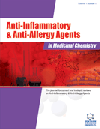- Home
- A-Z Publications
- Anti-Inflammatory & Anti-Allergy Agents in Medicinal Chemistry (Formerly Current Medicinal Chemistry - Anti-Inflammatory and Anti-Allergy Agents)
- Previous Issues
- Volume 13, Issue 2, 2014
Anti-Inflammatory & Anti-Allergy Agents in Medicinal Chemistry (Formerly Current Medicinal Chemistry - Anti-Inflammatory and Anti-Allergy Agents) - Volume 13, Issue 2, 2014
Volume 13, Issue 2, 2014
-
-
Efficacy and Safety of Inhaled and Intranasal Corticosteroids
More LessAuthors: Akefeh Ahmadiafshar and Sahar AhmadiafsharInflammation is an important phenomenon in allergic disorders and corticosteroid drugs since their anti inflammatory properties have a pivotal role in improvement, control and relieving the symptoms and signs of asthma, allergic rhinitis, atopic dermatitis and many other inflammatory disorders. Nevertheless, the prescription of these drugs might be associated with some unwanted reactions such as hyperglycemia, hyp Read More
-
-
-
Studies on Growth Kinetics of Serratia marcescens VITSD2 and Optimization of Fermentation Conditions for Serratiopeptidase Production
More LessAuthors: C. Subathra Devi, Shah Alam, Suraj Kumar Nag, S. Jemimah Naine, V. Mohanasrinivasan and B. VaishnaviSerratia is one of the most important groups of bacteria which produces proteolytic enzymes effectively and known to possess anti- inflammatory properties. The main focus of the current study was to optimize the culture conditions of Serratia marcescens VITSD2 for the mass production of serratiopeptidase. Effect of various nutritional and environmental factors were analysed and optimized. Among the different carbon and Read More
-
-
-
Benefits of Oral and Topical Administration of ROQUETTE Chlorella sp. on Skin Inflammation and Wound Healing in Mice
More LessThe human body is constantly exposed to the risk of traumatic lesions. Chlorella is a green microalgae enriched with nutrients, vitamins, minerals and chlorophyll. In some communities, Chlorella is a traditional medicinal plant used for the management of inflammation-related diseases. ROQUETTE Chlorella sp. (RCs) was investigated by oral administration (125, 250 and 500 mg/kg) and cutaneous application (2.5, 5.0 and Read More
-
-
-
The Effect of the Antioxidant Drug “U-74389G” on Oophoritis During Ischemia Reperfusion Injury in Rats
More LessThe aim of this experiment was to study the effects of the antioxidant drug “U-74389G” on rat model, particularly in ischemia reperfusion protocol. The beneficial or other effects of that molecule were studied estimating the mean oophoritis (OI) lesions. Materials and methods: 40 rats were used of mean weight 231.875 g. OI was evaluated 60 min after reperfusion for groups A and C and 120 min after reperfusion for groups B an Read More
-
-
-
Augmentation of Citalopram with Aspirin for Treating Major Depressive Disorder, a Double Blind Randomized Placebo Controlled Clinical Trial
More LessAuthors: Ahmad Ghanizadeh and Arvin HedayatiThere are contradictory reports about the association of cytokines levels and major depressive disorder and the possible therapeutic role of aspirin for treating major depressive disorder (MDD). A clinical sample of adult out-patients with MDD was recruited. At recruitment, they were interviewed face to face according to DSM-IV diagnostic criteria. In addition, Hamilton depression rating scale was completed by a psychiatrist. The Read More
-
-
-
Synthesis, Characterization and Anti-inflammatory Activity of N-(4- phenyl-1, 3-thiazol-2-yl)-N'-phenylureas
More LessA series of N-(4-phenyl-1, 3-thiazol-2-yl)-N'- phenylureas (5a-z) was synthesized from 2-amino-4-substituted phenylthiazoles and phenylisocyanates. The newly synthesized compounds were characterized by IR, 1H NMR and Mass spectral data. All the twenty six N-(4-phenyl-1, 3-thiazol-2-yl)-N'-phenylurea derivatives were screened for antiinflammatory activity by following carrageenan induced rat paw edema method. Among t Read More
-
-
-
A Novel Method Aimed at Counteracting the Side Effects Caused by Prostaglandin E2 Deficiency During Non-Steroidal Anti-Inflammatory Drug Therapy
More LessAuthors: Serghei Gargaun and Liubov GargaunBackground: Prostaglandin E2 (PGE2) plays key physiological roles within the body’s organs and the systemic environment. Non-steroidal anti-inflammatory drugs (NSAIDs) inhibit the biosynthesis of PGE2, which can lead to global PGE2 deficiency, resulting in serious side effects in the gastrointestinal, renal and other systems. In contrast, various pyridine derivatives have been found to increase endogenous PGE2 levels Read More
-
-
-
Synthesis of Some New Flurbiprofen Analogues as Anti-inflammatory Agents
More LessAuthors: Laxmikant H. Nitlikar, Jaiprakash N. Sangshetti and Devanand B. ShindeA series of new α-aryl propionic acid derivatives had been synthesized through different synthetic routes from the readily available 2-fluoronitrobenzene as key starter. The synthesized compounds were screened for their antiinflammatory activity using rat paw edema method. Azoles (6c, 6h and 6i) have showed considerable good antiinflammatory activity. The present series with some modification may serve a Read More
-
Volumes & issues
-
Volume 24 (2025)
-
Volume 23 (2024)
-
Volume 22 (2023)
-
Volume 21 (2022)
-
Volume 20 (2021)
-
Volume 19 (2020)
-
Volume 18 (2019)
-
Volume 17 (2018)
-
Volume 16 (2017)
-
Volume 15 (2016)
-
Volume 14 (2015)
-
Volume 13 (2014)
-
Volume 12 (2013)
-
Volume 11 (2012)
-
Volume 10 (2011)
-
Volume 9 (2010)
-
Volume 8 (2009)
-
Volume 7 (2008)
-
Volume 6 (2007)
-
Volume 5 (2006)
Most Read This Month
Article
content/journals/aiaamc
Journal
10
5
false
en


